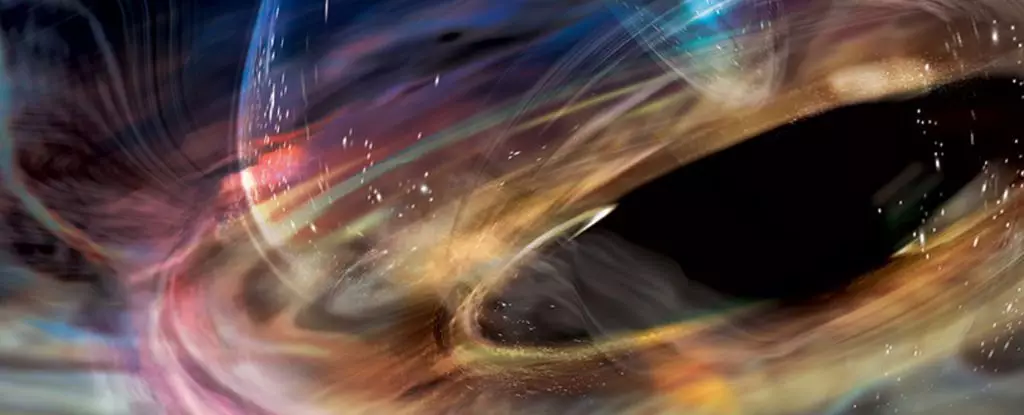The cosmos is full of mysteries, and among them lies a peculiar black hole known as 1ES 1927+654, situated approximately 275 million light-years away in a distant galaxy. Unlike any other black hole observed to date, its unusual behavior poses a significant challenge to our understanding of cosmic phenomena. Recent research has shed light on its erratic actions, suggesting a white dwarf star is dangerously grazing the edges of its event horizon—an area from which nothing can escape its gravitational grasp. This discovery may offer a deeper insight into the lives of celestial bodies in extreme environments.
Physicist Megan Masterson from the Massachusetts Institute of Technology (MIT) highlights the importance of this finding, noting that the presence of a white dwarf so close to a black hole is unprecedented. The implications are profound: it indicates that such compact objects might exist for extended periods near the event horizon, eluding total consumption. Observing fluctuations in light emissions effectively allows astronomers to piece together the chaotic interactions occurring in black holes’ vicinity.
Typically, black holes elude direct observation as they emit no light. Instead, the electromagnetic emissions generated by surrounding materials are our conduit for understanding these enigmas. When a star ventures too close, tidal forces can rip it apart, adding to the complexity of cosmic dance observed around these giants. Notably, the black hole at the helm of 1ES 1927+654, weighing in at around one million solar masses, displayed peculiar behaviors starting in 2018 when its corona vanished and later enhanced its luminosity nearly twentyfold.
In 2022, astronomers utilizing the European Space Agency’s XMM-Newton space telescope detected notable variability in X-ray emissions from 1ES 1927+654—output fluctuating roughly ten percent on intervals of 18 minutes. This phenomenon, widely referred to as quasi-periodic oscillations, intrigued researchers who had not previously encountered such drastic changes. The period between these fluctuations plummeted to under seven minutes over two years, leading scientists to reconsider their understanding of black hole behavior.
Masterson explains that this rapid variability deviated significantly from what is traditionally observed: “This looked absolutely nothing like a normal black hole.” The implications are significant; it forces a reevaluation of solidified models previously used to explain black hole emissions.
To dissect the ongoing cosmic antics of 1ES 1927+654, researchers meticulously analyzed the attributes of the emitted light. Erin Kara, also from MIT, emphasizes that the observed X-ray emissions suggest proximity to the event horizon. When variability occurs on such brief timescales, the clear assumption is that an object is in orbit around the black hole, and there’s a strong possibility this dense entity is the white dwarf star.
Initially, researchers contemplated multiple scenarios, ultimately converging on the notion of a dense object spiraling toward the black hole. The calculations revealed a white dwarf—a remnant of a low-mass star—skimming tantalizingly close to the event horizon. Notably, this stellar remnant is compacting an impressive mass similar to 0.1 times that of our Sun within a volume between the Earth and the Moon.
In this celestial ballet, the white dwarf’s close quarters with the black hole may forge an excursion unlike any recorded. While gravitational forces threaten to tear it apart, the dense nature of the white dwarf could allow it to maintain its integrity, pushing back against the relentless pull of the black hole’s gravity. This dynamic could lead to a unique outcome: the star might experience sufficient momentum to ascend away from the danger zones.
If researchers’ predictions hold true, further observations may illuminate this cosmic epic as the white dwarf’s oscillation period extends. As the nature of this extraordinary interaction continues to unfold, it shines a light on the extreme environments surrounding black holes, allowing scientists to refine their models of gravitational forces at play.
Scientists remain resolute in their commitment to observing this remarkable phenomenon, recognizing that the black hole at the center of 1ES 1927+654 has much more to teach regarding significant gravitational conditions across the universe. As Master’s profound observation underscores, the unpredictable nature of this cosmic entity demands constant vigilance. The excitement surrounding this research continues to mount as astronomers remain poised for future discoveries that could reshape our comprehension of the universe.
In a profound and ever-evolving journey, the enigmatic black hole signals the potential for understanding the balance between creation and destruction prevalent in our cosmos. Embracing these cosmic mysteries may ultimately lead to a more comprehensive understanding of gravitational mechanics and stellar evolution in the grand tapestry of existence.

